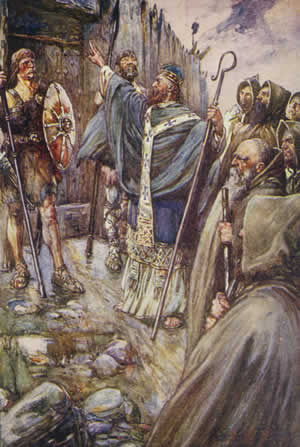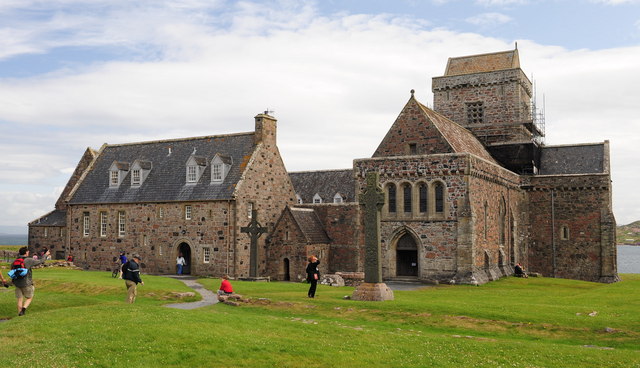|
Ségéne Mac Fiachnaí
Ségéne mac Fiachnaí (or Ségéne of Iona) (died 12 August 652) was the fifth abbot of the Iona Abbey in Scotland (623–652). Ségéne was of the Cenél Conaill, the same kindred as Columba, and he was the nephew of a previous abbot, Lasrén. It was during Ségéne's long abbacy that the famous controversy regarding the dating of Easter first made itself properly felt. Ségéne was the recipient of a letter on the dating Easter which has been dated to ''c''. 632/3.Ó Cróinín and Walsh, 1988, pp. 3-7. Ségéne is known to have vigorously defended the Gaelic dating, and put his name to a letter written by the Gaelic clergy to Pope Severinus in 638. Ségéne also established the first Gaelic missionaries amongst the English, sending Corman and then Áedan, the latter of whom, with the help of King Oswald of Northumbria (who himself had spent time in exile at Iona), established a daughter house and bishopric at Lindisfarne Lindisfarne, also called Holy Island, is a tidal ... [...More Info...] [...Related Items...] OR: [Wikipedia] [Google] [Baidu] |
Abbot Of Iona
The Abbot of Iona was the head of Iona Abbey during the Middle Ages and the leader of the monastic community of Iona, as well as the overlord of scores of monasteries in both Scotland and Ireland, including Durrow, Kells and, until the Synod of Whitby, Lindisfarne. It was one of the most prestigious clerical positions in Dark Age Europe, and was visited by kings and bishops of the Picts, Franks and English. The Ionan abbots also had the status of Comarba of Colum Cille, i.e. the successors of that Saint, Columba.Some sources refer to earlier abbots as Abbot of Hy. "Hy" being an early name for Iona (see Iona: Etymology and "He considered him as contemporary with Mugron, abbot of Hy (''d''. 980)..." ()) Iona's position as head of the Columban network (''familia'') of churches declined over time, with abbots based at Derry, Raphoe, Kells and Dunkeld. In Scotland, the abbots of Dunkeld ruled much of central Scotland in the 11th century, and functioned as some of the most important ... [...More Info...] [...Related Items...] OR: [Wikipedia] [Google] [Baidu] |
Bishop Of Lindisfarne
The Bishop of Durham is the Church of England, Anglican bishop responsible for the Diocese of Durham in the Province of York. The diocese is one of the oldest in England and its bishop is a member of the House of Lords. Paul Butler (bishop), Paul Butler has been the Bishop of Durham since his Confirmation of bishops, election was confirmed at York Minster on 20 January 2014.Archbishop of York – Bishop of Durham Election Confirmed (Accessed 20 January 2014) The previous bishop was Justin Welby, now Archbishop of Canterbury. The bishop is one of two (the other is the Bishop of Bath and Wells) who escort the sovereign at the Coronation of the British monarch, coronation. He is officially styled ''The Right Reverend ... [...More Info...] [...Related Items...] OR: [Wikipedia] [Google] [Baidu] |
7th-century Irish Abbots
The 7th century is the period from 601 ( DCI) through 700 ( DCC) in accordance with the Julian calendar in the Common Era. The spread of Islam and the Muslim conquests began with the unification of Arabia by Muhammad starting in 622. After Muhammad's death in 632, Islam expanded beyond the Arabian Peninsula under the Rashidun Caliphate (632–661) and the Umayyad Caliphate (661–750). The Muslim conquest of Persia in the 7th century led to the downfall of the Sasanian Empire. Also conquered during the 7th century were Syria, Palestine, Armenia, Egypt, and North Africa. The Byzantine Empire suffered setbacks during the rapid expansion of the Caliphate, a mass incursion of Slavs in the Balkans which reduced its territorial limits. The decisive victory at the Siege of Constantinople in the 670s led the empire to retain Asia Minor which assured the existence of the empire. In the Iberian Peninsula, the 7th century was known as the ''Siglo de Concilios'' (century of councils) ... [...More Info...] [...Related Items...] OR: [Wikipedia] [Google] [Baidu] |
Abbots Of Iona
The Abbot of Iona was the head of Iona Abbey during the Middle Ages and the leader of the monastic community of Iona, as well as the overlord of scores of monasteries in both Scotland and Ireland, including Durrow, Kells and, until the Synod of Whitby, Lindisfarne. It was one of the most prestigious clerical positions in Dark Age Europe, and was visited by kings and bishops of the Picts, Franks and English. The Ionan abbots also had the status of Comarba of Colum Cille, i.e. the successors of that Saint, Columba.Some sources refer to earlier abbots as Abbot of Hy. "Hy" being an early name for Iona (see Iona: Etymology and "He considered him as contemporary with Mugron, abbot of Hy (''d''. 980)..." ()) Iona's position as head of the Columban network (''familia'') of churches declined over time, with abbots based at Derry, Raphoe, Kells and Dunkeld. In Scotland, the abbots of Dunkeld ruled much of central Scotland in the 11th century, and functioned as some of the most important ... [...More Info...] [...Related Items...] OR: [Wikipedia] [Google] [Baidu] |
652 Deaths
65 may refer to: * 65 (number) * ''65'' (film), an upcoming American science fiction thriller film * One of the years 65 BC, AD 65, 1965, 2065 * A type of dish in Indian cuisine, such as Chicken 65, Gobi 65, or Paneer 65 {{Numberdis ... [...More Info...] [...Related Items...] OR: [Wikipedia] [Google] [Baidu] |
Suibne I Of Iona , early 13th century Scottish magnate, eponym of Castle Sween and the MacSweens of Argyll and Ireland
{{hndis ...
Suibne or Suibhne, a Gaelic male name from which the modern '' Sweeney'' is derived, may refer to: * Suibne mac Colmáin (died c. 598), Irish king * Suibne Menn (died c. 628), Irish king * Suibne moccu Fir Thrí (died c. 657), abbot of Iona * Suibne son of Maclume (died c. 891), famed scribe of Clonmacnoise * Suibne mac Cináeda (died 1034), King of the ''Gall Gaidheil'' * Suibne Geilt ("Sweeney the Wild"), protagonist of the Irish language tale ''Buile Shuibhne'' (''The Madness of Sweeney'') * Suibhne mac Duinnshléibhe Suibhne mac Duinnshléibhe was a late 12th-century, and early 13th-century, lord in Argyll. He does not appear in contemporary records, although his name appears in the patronymic names of two of his sons. Suibhne appears in the 16th century '' L ... [...More Info...] [...Related Items...] OR: [Wikipedia] [Google] [Baidu] |
Lindisfarne
Lindisfarne, also called Holy Island, is a tidal island off the northeast coast of England, which constitutes the civil parish of Holy Island in Northumberland. Holy Island has a recorded history from the 6th century AD; it was an important centre of Celtic Christianity under Saints Aidan, Cuthbert, Eadfrith, and Eadberht of Lindisfarne. After the Viking invasions and the Norman conquest of England, a priory was re-established. A small castle was built on the island in 1550. Name and etymology Name Both the Parker and Peterborough versions of the Anglo-Saxon Chronicle for 793 record the Old English name . In the 9th-century the island appears under its Old Welsh name . The philologist Andrew Breeze, following up on a suggestion by Richard Coates, proposes that the name ultimately derives from Latin (English: Healing sland, owing perhaps to the island's reputation for medicinal herbs. The name Holy Island was in use by the 11th century when it appears in Latin as . The ... [...More Info...] [...Related Items...] OR: [Wikipedia] [Google] [Baidu] |
Oswald Of Northumbria
Oswald (; c 604 – 5 August 641/642Bede gives the year of Oswald's death as 642, however there is some question as to whether what Bede considered 642 is the same as what would now be considered 642. R. L. Poole (''Studies in Chronology and History'', 1934) put forward the theory that Bede's years began in September, and if this theory is followed (as it was, for instance, by Frank Stenton in his notable history ''Anglo-Saxon England'', first published in 1943), then the date of the Battle of Heavenfield (and the beginning of Oswald's reign) is pushed back from 634 to 633. Thus, if Oswald subsequently reigned for eight years, he would have actually been killed in 641. Poole's theory has been contested, however, and arguments have been made that Bede began his year on 25 December or 1 January, in which case Bede's years would be accurate as he gives them.) was King of Northumbria from 634 until his death, and is venerated as a saint, of whom there was a particular cult in the ... [...More Info...] [...Related Items...] OR: [Wikipedia] [Google] [Baidu] |
Iona Abbey
Iona Abbey is an abbey located on the island of Iona, just off the Isle of Mull on the West Coast of Scotland. It is one of the oldest Christian religious centres in Western Europe. The abbey was a focal point for the spread of Christianity throughout Scotland and marks the foundation of a monastic community by St. Columba, when Iona was part of the Kingdom of Dál Riata. Saint Aidan served as a monk at Iona, before helping to reestablish Christianity in Northumberland, on the island of Lindisfarne. Iona Abbey is the spiritual home of the Iona Community, an ecumenical Christian religious order, whose headquarters are in Glasgow. The Abbey remains a popular site of Christian pilgrimage today. History Early history In 563, Columba came to Iona from Ireland with twelve companions, and founded a monastery. It developed as an influential centre for the spread of Christianity among the Picts and Scots. At this time the name of the island and so the abbey was "Hy" or "Hii"; ... [...More Info...] [...Related Items...] OR: [Wikipedia] [Google] [Baidu] |
Aidan Of Lindisfarne
Aidan of Lindisfarne ( ga, Naomh Aodhán; died 31 August 651) was an Irish monk and missionary credited with converting the Anglo-Saxons to Christianity in Northumbria. He founded a monastic cathedral on the island of Lindisfarne, known as Lindisfarne Priory, served as its first bishop, and travelled ceaselessly throughout the countryside, spreading the gospel to both the Anglo-Saxon nobility and the socially disenfranchised (including children and slaves). He is known as the Apostle of Northumbria and is recognised as a saint by the Catholic Church, the Eastern Orthodox Church, the Anglican Communion, and others. Biography Bede's meticulous and detailed account of Aidan's life provides the basis for most biographical sketches (both classical and modern). Bede says virtually nothing of the monk's early life, save that he was a monk at the ancient monastery on the island of Iona from a relatively young age and that he was of Irish descent. According to Catholic tradition, in Aidan ... [...More Info...] [...Related Items...] OR: [Wikipedia] [Google] [Baidu] |
Pope Severinus
Pope Severinus (died 2 August 640) was the bishop of Rome elected in October 638. He was caught up in a power struggle with Emperor Heraclius, who pressured him to accept Monothelitism. Severinus refused, which for over eighteen months hindered his efforts to obtain imperial recognition of his election. His pontificate was finally sanctioned on 28 May 640, but he died two months later. Early career Severinus was a Roman. His father was named Avienus, according to the ''Liber Pontificalis''. The name of the father suggests descent from members of the Roman Senate.Martindale, Jones & Morris (1992), p. 155 A previous Avienus was Roman consul in 501. Already an old man, Severinus was elected to succeed Honorius I as pope in mid-October 638. Monothelite controversy Patriarch Sergius I of Constantinople had drawn up the ''Ecthesis'' in response to the orthodox synodical letter of Patriarch Sophronius of Jerusalem. On learning of the death of Honorius, Sergius convinced Emperor Herac ... [...More Info...] [...Related Items...] OR: [Wikipedia] [Google] [Baidu] |



.jpg)

